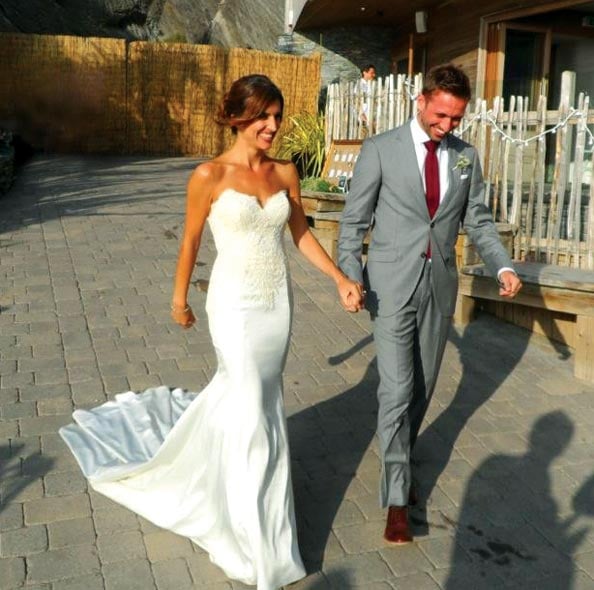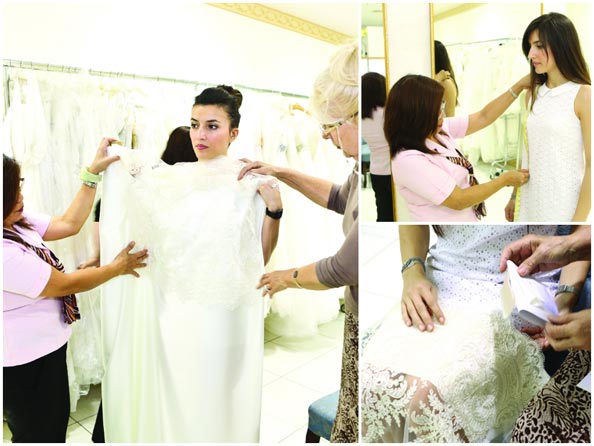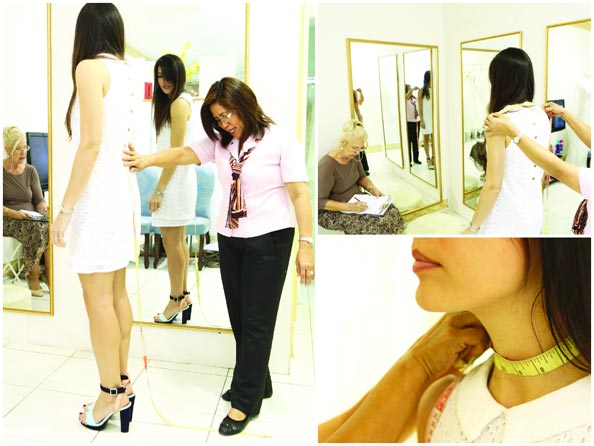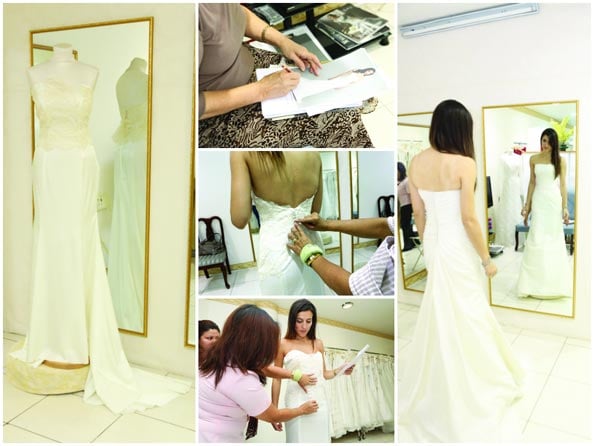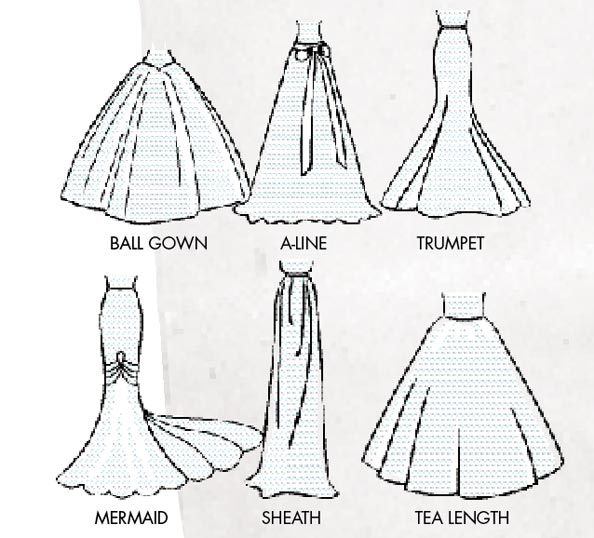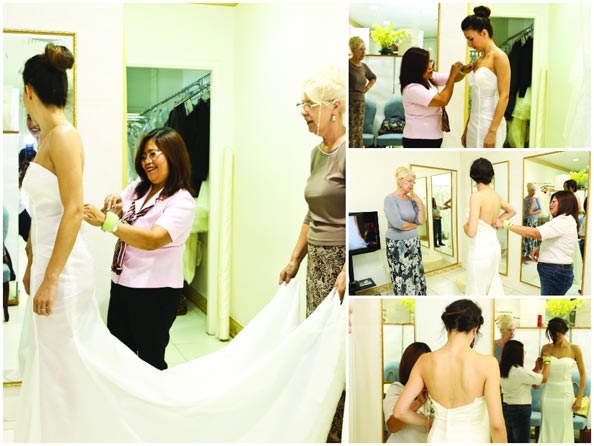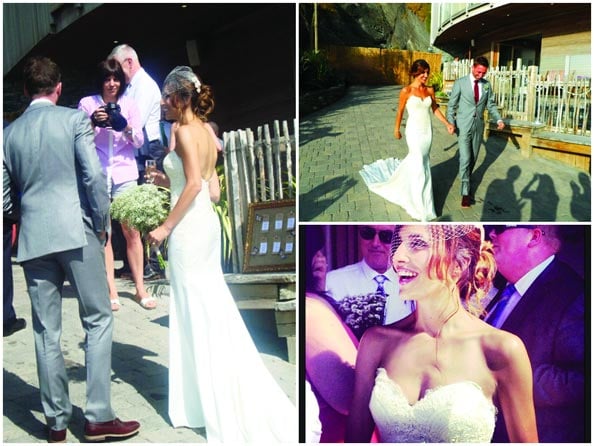Creating your own dress from scratch has become the ideal way for a bride-to-be to feel totally unique. Alexandria Gouveia looked into the new trend with Dubai’s legendary dressmaker, Anne Rashid.
STEP ONE: CHOOSING THE MATERIAL & MEASUREMENTS
Material
WHAT TO CHOOSE
“The main materials used are lace, satin, silk satin, raw silk, taffeta, organza and chiffon. We decide which ones to use based on the design of the dress. For example, silk chiffon is ideal for soft feminine fluid gowns and works well for an empire or bias cut. Organza and tulle are perfect for full-skirted ball gowns. Taffeta, raw silk and satin are suited for more structured styles while lace and embroidered tulle are suitable for mermaid and A-line styles.
“However, these fabrics come in different weights. For instance, corded lace is heavier than non-corded lace, organza can sometimes be stiff and extremely rigid while tulle can vary from soft and delicate to crisp to the touch. It all depends on the look you want to achieve and the style of the dress.”
HOW TO LOOK FOR QUALITY
“Apart from how the material actually looks, the feel of the fabric is another indicator. Fabrics that split or fray easily or those that crease badly are not ideal. There are ways of reducing the amount of creasing – but this is one of our closely guarded secrets! The price does not always determine the quality of the fabric, but if it seems too good to be true, then it usually is.”
CHOOSING MATERIAL COLOUR
“Just draping the fabric sample around your neck and shoulders will help you discover which colour is most complementary. See the fabric in daylight as artificial lighting can be very deceptive.”
POPULAR FABRICS
Batiste: A lightweight, transparent fabric.
Brocade: A Jacquard-woven fabric with raised designs.
Charmeuse: A lightweight, semi-lustrous soft fabric that is satin-like to the touch.
Chiffon: Delicate and sheer. Popular for overskirts, sheer sleeves and wraps.
Crepe: A light, soft and thin fabric with a crinkled surface.
Duchesse Satin: A lightweight hybrid of silk and rayon woven into a satin finish.
Georgette: A sheer, lightweight fabric made of polyester or silk with a crepe surface.
Moire: A heavy silk taffeta with a subtle, wavy design.
Organza: Crisp and sheer like chiffon, with a stiffer texture similar in effect to tulle, but more flowing; popular for skirts, sleeves, backs and overlays.
Satin: A heavy, smooth fabric with a high sheen on one side.
Silk: The most cherished fibre for wedding dresses (and also the most expensive).
Taffeta: Crisp and smooth, with a slight rib.
Tulle: Netting made of silk, nylon or rayon; used primarily for skirts and veils.
MEASUREMENTS
“We take full body measurements (including hips, waist, neck, length and shoulders) and work to our own specially devised and highly detailed measure charts. Most of our brides say they didn’t realise they had so many places to measure,” says Anne.
STEP TWO: CHOOSING STYLE & SHAPE
Try on ready-made dresses first
“Looking at wedding gowns in magazines is a good place to start but I always suggest trying on different styles of gowns to decide which is the most flattering shape,” says Anne. “It depends on which parts of the body the bride wishes to accentuate and which she would rather disguise. By the end of the trying-on session it should be easy to decide the design of the neckline and the most complementary style of skirt.
“As well as trying on ready-made dresses I like to go through designs of styles that the bride likes and discussing shapes and tastes and how we can tailor it to the bride.”
WHAT TO THINK ABOUT:
Popular embellishments
“Beaded belts and appliques are very popular. We make them to any design using beads and crystals to match those on the dress, or if the dress has no embellishments then to match jewellery, hair combs or veil edgings. Detachable trains can also be added; they are ideal for making a dramatic entrance and can be removed easily before the first dance!”
Corsets and bras
“The corset is perfect for curvy and pear shaped brides as the waist instantly appears very much smaller. For the small chested
“Silicone stick-on cups are more suited to the smaller bust and work well with low back dresses. Alternatively a padded underwired bra can be stitched into the dress.”
Neckline Styles
Portrait: A delicate scoop that frames the shoulders and collarbone, this is a safe option if you have full arms and prominent collarbones.
Scoop: Works well for most body types. Add more drama with a low cut. Alternatively for a more modest look opt for a higher neckline.
Queen Anne: Ideal for the more confident bride. This style sits high on the back of the neck and opens along the lower front of the chest, across the front of the neck. It can help elongate a figure or display a discreet amount of cleavage.
Jewel: Following the curvature of the neck, this works well for women who want to enhance their chest. However, avoid if you’re well-endowed.
Sweetheart: This heart shape bust line is a more flattering strapless neckline for the small chested as it accentuates the cleavage.
Strapless: If you have fabulous toned shoulders and noticeable collarbones then this style is perfect.
Asymmetric: A modern neckline for the bride with unique taste. Avoid if you have broad shoulders.
Skirt Styles
Ballgown: A popular fairy tale princess silhouette with a fitted bodice and a full skirt. Ideal for most body types but best on pears, as it hides the lower body. It can be overwhelming on petite frames.
A-Line: The most flattering for body types. A narrow waist that flows out to the ground. Particularly good for pear and hourglass figures.
Trumpet: A modified A-line shape, however instead of flowing from the waits it skims the body before flaring out mid-thigh. Ideal for hourglass shapes and the petite. Avoid if paranoid about your stomach and hips.
Mermaid: Fitted from the chest to the knee, where it flares out with a fan train. Ideal for slender frames and hourglass body types who are willing to show off their curves.
Sheath: Narrow shape flowing straight down from the neckline to the hem. Ideal for lean frames and hourglasses who are willing to show off their curves. Be wary that sheaths will accentuate extra inches and can be unflattering.
Tea-Length: A vintage style that falls in between the ankle and the knee. Ideal for all body types.
STEP THREE: FITTINGS
What’s the next step?
“After taking full measurements and making the desired dress pattern the bride is called back to do a fitting of the lining. This ensures that we have the perfect body shape before we cut the chosen fabric. At this stage minor changes can be made. For example the neck depth can be lowered, straps can be made narrower and the train can be shortened.
“Following this, the next step is to have a fitting in the selected fabric with the lining underneath. If the dress has lace or tulle over the silk or satin then this will be attached in the next fitting.
“Hopefully six fittings should be enough. However some brides lose or gain weight so this number can increase. If the bride-to-be loses weight the dress can be made smaller. However, if there is some weight gain then it is more difficult as stitching can show where seams have been let out
“The boning is put into the lining in the early fittings. Whereas buttons and embellishments are the last things to be added.”
After the lining fitting
1.The lace top is tacked onto the dress
2. The seamstress checks lace alignment on the bodice
3. Buttons are put in place
4. A pearl bracelet is stitched onto the dress, making it easy to carry
STEP FOUR: THE FINAL DRESS
Anne’s tops tips when choosing your tailor
1. Plan well ahead. Good seamstresses are always busy.
2. Look at fabric and get samples, but do not buy any. Your tailor will advise you on quality and quantity.
3. Ask to see pictures of previously made dresses.
4. Be honest about your budget but also be realistic.
5. Make sure your tailor suggests a lining or calico fitting before your fabric is cut.
6. For your fittings remember to bring underwear and shoes similar to those you intend to wear for your wedding.
7. If you have doubts about the capability of your tailor find another one! Complete trust and confidence are essential.
8. Be wary of your wedding location when choosing your design. A long train and veil would be inappropriate for a beach wedding but perfect for a church ceremony. The gown should reflect the level of formality (or informality) and compliment any cultural flavour of the ceremony and reception.
Prices vary according to style and fabric.
Photography by Vikram Gawde | Illustrations by Maxim Savva








